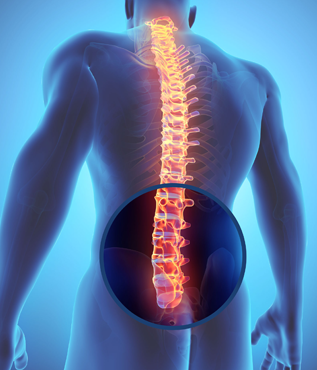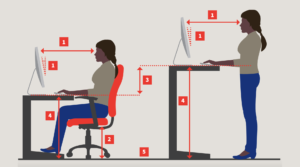The Unbearable Ache: Demystifying Back Pain
Have you ever woken up feeling like someone replaced your mattress with a bed of rocks? Or maybe a dull ache sets in after a long day hunched over your desk. Back pain, it seems, is an unwelcome guest that visits many of us at some point.

According to the World Health Organization, lower back pain is the global champion of disability, affecting people across all walks of life. It’s not just a personal inconvenience, either. Back pain costs societies a significant chunk of change due to lost productivity and healthcare expenses.
But beyond the numbers, there’s the real you, dealing with the sharp twinge that throws your morning routine into chaos, the nagging ache that lingers after work, or the persistent pain that limits your favorite activities.
The thing is, back pain isn’t just one big monster. It comes in various forms, each with its own set of characteristics and potential causes. Lower back pain, often called lumbago, is the most common culprit, often caused by strained muscles or ligaments. Upper back pain, typically felt between your shoulder blades, can be triggered by things like poor posture, stress, or repetitive movements. And for some individuals, chronic pain becomes a harsh reality, significantly impacting their daily lives. Radiating pain, a shooting or tingling sensation that travels beyond the initial discomfort, can be a sign of underlying conditions like sciatica.
Understanding the different types of back pain and their potential causes is the first step towards finding relief. This guide will delve deeper into the world of back pain, exploring its various forms, potential triggers, and available management strategies. By arming yourself with information and seeking professional guidance when necessary, you can embark on a journey towards a pain-free future.
Unveiling the Back: An Anatomical Overview
The Backstage of Movement: Unveiling the Back’s Anatomy
Imagine your back as a complex, intricate machine responsible for movement, support, and flexibility. Understanding its key components is essential to appreciating its remarkable capabilities and potential vulnerabilities.
The Backbone of Support: The Spine
The cornerstone of the back’s architecture is the spine, a flexible column composed of 26 individual bones called vertebrae. These vertebrae interlock, forming a sturdy yet movable structure that provides support and allows for bending, twisting, and other movements. Each vertebra has a hollow center that houses and protects the spinal cord, a bundle of nerves that transmits messages between the brain and the rest of the body.

The Powerhouse of Movement: Muscles
Supporting the spine and enabling movement is a network of powerful muscles. These muscles can be broadly categorized into two groups:
- Superficial muscles: These lie closer to the surface and are responsible for various movements like bending, twisting, and extending the spine. Examples include the latissimus dorsi (lats) and the trapezius muscles.
- Deep core muscles: Located deeper within the body, these muscles provide stability and support to the spine. Examples include the erector spinae and the transversus abdominis muscles.
The Cushioning System: Discs
Between each vertebra except the first and the last lies a disc. These discs act as shock absorbers, cushioning the vertebrae and allowing for smooth, pain-free movement. Each disc has a tough, fibrous outer ring and a soft, gel-like inner core.
Maintaining Balance: Posture
The intricate interplay between these components – the spine, muscles, and discs – allows for a crucial function: posture. Proper posture involves maintaining a natural alignment of the spine, distributing weight evenly, and minimizing strain on the back muscles. This alignment helps us stand tall, sit upright, and move efficiently, reducing the risk of back pain and injuries.

Visualizing the Back’s Anatomy
Understanding the back’s anatomy doesn’t require memorizing complex names. Referring to diagrams or illustrations can significantly enhance your comprehension. Visualizing the location and function of each component can provide a clearer picture of this remarkable system that supports our everyday movements.

By delving into the back’s anatomical marvels, we gain a deeper appreciation for its complexity and vulnerability. This understanding empowers us to approach activities mindfully and prioritize practices that promote back health and prevent potential pain.
Unmasking the Many Faces of Back Pain
Back pain isn’t a one-size-fits-all monster. It comes in various forms, each with its own set of characteristics and potential causes. Let’s explore three common types to help you identify yours:
The Lower Back Blues:
- Lower back pain, or lumbago as some folks call it, is the most frequent visitor, paying up to 80% of individuals a visit at some point.
- It often shows up as a dull ache or a sharp jab in the lower back, sometimes even traveling down to your glutes or legs.
- Common culprits include:
- Muscle strain or sprain: Overdoing it at the gym, lifting heavy objects with improper form, or simply maintaining awkward postures for too long can strain the muscles and ligaments in your lower back, leading to pain and stiffness.
- Herniated disc: Imagine the soft, gel-like center of a disc bulging or even rupturing – that’s a herniated disc. When this happens, it can press on nearby nerves, causing pain, numbness, and weakness.
- Sciatica: This specific type of pain is like a firecracker going off in your lower back and shooting down one or both legs, often following the path of the sciatic nerve. It can be caused by a herniated disc or other conditions that compress the nerve.
The Upper Back’s Burden:
- Upper back pain often feels like a dull ache or tightness between your shoulder blades, sometimes even extending to your shoulders or neck.
- It can stem from various factors, including:
- Poor posture: Slouching, hunching over your computer all day, or having rounded shoulders can put a strain on the muscles and ligaments in your upper back, leading to pain and discomfort.
- Repetitive strain injuries: Activities like spending hours hunched over your keyboard or certain sports that involve repetitive movements can overuse muscles in your upper back, leading to pain and inflammation.
- Stress: Feeling overwhelmed? Tightness in your upper back muscles can be a common way your body reacts to stress and anxiety.
The Persistent Shadow: Chronic Pain
- Chronic pain refers to pain that becomes a persistent companion, staying with you for longer than 12 weeks despite treatment.
- It can significantly impact your daily life, affecting your sleep, work, and overall well-being.
- Back pain can become chronic due to various reasons, including:
- Underlying medical conditions: Arthritis, spinal stenosis (where the spinal canal narrows), and other conditions can contribute to chronic back pain.
- Psychological factors: Depression, anxiety, and stress can worsen or even perpetuate chronic pain, creating a complex cycle.
Remember, you’re not alone!
While these categories provide a basic framework, it’s important to remember that back pain can be highly individual. The specific location, intensity, and duration of your pain can vary greatly depending on the underlying cause.
Seeking professional guidance is key.
If you experience back pain, it’s crucial to consult a doctor or healthcare professional. They can help diagnose the cause of your pain and recommend appropriate treatment options, which may include:
- Rest: Sometimes, all you need is a break from strenuous activities to allow your body to heal and the pain to subside.
- Medication: Over-the-counter pain relievers, muscle relaxants, or other medications may be prescribed depending on the cause and severity of your pain.
- Physical therapy: Specific exercises and stretches can help strengthen your core muscles, improve flexibility, and reduce pain.
- Alternative therapies: In some cases, alternative therapies like acupuncture, massage, or yoga may be considered as complementary treatments.
By understanding the different types of back pain and their potential causes, you can take charge of your health and seek professional help when necessary. Remember, back pain doesn’t have to be a constant companion. With proper diagnosis and treatment, you can journey towards a pain-free and fulfilling life.
Seeking Solutions: Management and Treatment Options
Back pain can disrupt your daily routine and leave you searching for relief. Fortunately, an array of treatment options exist, empowering you to take charge of your well-being. This section delves into various approaches, but remember, consulting a healthcare professional is crucial for proper diagnosis and personalized treatment.
Taking Charge: Self-Care Strategies
Self-care is the cornerstone of back pain management. Here are some strategies to incorporate into your daily routine:
- Rest: While not complete inactivity, taking a break from strenuous activities can allow your body to heal. Listen to your body’s signals and prioritize adequate rest.
- Heat or ice therapy: Applying a heating pad or ice pack to the affected area can help reduce inflammation and pain.
- Maintaining good posture: Standing tall, sitting with proper back support, and avoiding slouching can significantly reduce strain on your back.
- Staying active: Regular exercise, including low-impact activities like walking, swimming, or yoga, can strengthen core muscles, improve flexibility, and reduce pain. However, always consult a healthcare professional before starting any new exercise program.
Seeking Professional Guidance: Physical Therapy and Medication
If self-care measures don’t provide sufficient relief, consulting a healthcare professional is essential. They can assess your specific condition and recommend appropriate treatment options, which may include:
- Physical therapy: A physical therapist can design a personalized exercise program to strengthen muscles, improve flexibility, and address specific movement dysfunctions contributing to your pain.
- Medication: Over-the-counter pain relievers like ibuprofen or acetaminophen can offer temporary relief. In some cases, stronger pain medications or muscle relaxants might be prescribed by a doctor. It’s crucial to follow medication instructions carefully and never exceed the recommended dosage.
Exploring Alternatives: Complementary Therapies
While not a substitute for conventional treatment, some complementary therapies may offer additional pain relief for certain individuals. These include:
- Acupuncture: This traditional Chinese medicine practice involves inserting thin needles into specific points on the body. While research on its effectiveness for back pain is ongoing, some individuals find it beneficial.
- Massage therapy: Massage can help relax muscles, improve circulation, and reduce pain. However, it’s important to inform the massage therapist about your back pain and any limitations you may have.
- Mind-body practices: Techniques like yoga, meditation, and tai chi can promote relaxation, reduce stress, and improve pain management.
Remember:
- Early diagnosis and intervention are crucial for effective back pain management. Consulting a healthcare professional ensures you receive the proper diagnosis and personalized treatment plan.
- Treatment options vary depending on the cause and severity of your back pain. There’s no “one-size-fits-all” solution, and what works for one person may not work for another.
- Open communication with your healthcare professional is essential. Discuss your concerns, treatment options, and any potential side effects thoroughly.
By understanding the available treatment options and actively participating in your healthcare journey, you can empower yourself to manage your back pain and live a fulfilling life.
Conclusion: Prevention is Key
Back pain can be a real drag, throwing a wrench into our daily routines and leaving us searching for relief. But the good news is, we’re not powerless against it! By taking a proactive approach, we can significantly reduce our risk of experiencing back pain and keep our bodies moving freely.
Standing Tall: The Power of Posture
Good posture is the cornerstone of back health. Imagine yourself with a strong, invisible string pulling your head up towards the ceiling. When sitting, ditch the slouch and ensure your back is well-supported, with your feet flat on the floor. Standing tall with relaxed, pulled-back shoulders is key. If you spend a lot of time at a desk, consider a standing desk or a lumbar support cushion to maintain that healthy posture.
Moving Matters: Exercise is Your Friend
Regular physical activity is a magic bullet for back health. Aim for at least 150 minutes of moderate-intensity exercise or 75 minutes of vigorous activity each week, as recommended by the American Physical Therapy Association . Don’t forget to strengthen your core, back muscles, and glutes with specific exercises. Remember, consulting a healthcare professional before starting any new program, especially if you have any pre-existing conditions, is always a wise move.
Lifestyle Choices: Small Changes, Big Impact
Maintaining a healthy weight takes the pressure off your spine and reduces your risk of back pain. Staying hydrated and eating a balanced diet rich in fruits, vegetables, and whole grains nourishes your body and keeps those muscles strong.
Ergonomics: Making Your Space Work for You
Whether you’re conquering your inbox or tackling household chores, good ergonomics are key. When sitting, adjust your chair height and armrests for proper support. Take breaks to stretch and adjust your posture, especially if you drive frequently. Remember, even small tweaks in your daily routine can make a big difference in preventing back pain.
Exploring Additional Support: FlexifyMe as a Resource
While these tips provide a solid foundation, seeking professional guidance can be incredibly beneficial. Resources like FlexifyMe offer personalized exercise programs designed by certified trainers and experienced physiotherapists. Their AI technology provides real-time feedback on your movements, helping you maintain proper form and avoid injuries. However, it’s important to remember that consulting a healthcare professional is always recommended for personalized advice and treatment plans tailored to your specific needs.
By prioritizing prevention and incorporating these simple yet effective strategies into your daily life, you can empower yourself to take control of your back health and move with confidence towards a pain-free and active future. Remember, prevention is key!


